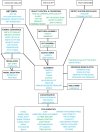Osiris: accessible and reproducible phylogenetic and phylogenomic analyses within the Galaxy workflow management system
- PMID: 24990571
- PMCID: PMC4227113
- DOI: 10.1186/1471-2105-15-230
Osiris: accessible and reproducible phylogenetic and phylogenomic analyses within the Galaxy workflow management system
Abstract
Background: Phylogenetic tools and 'tree-thinking' approaches increasingly permeate all biological research. At the same time, phylogenetic data sets are expanding at breakneck pace, facilitated by increasingly economical sequencing technologies. Therefore, there is an urgent need for accessible, modular, and sharable tools for phylogenetic analysis.
Results: We developed a suite of wrappers for new and existing phylogenetics tools for the Galaxy workflow management system that we call Osiris. Osiris and Galaxy provide a sharable, standardized, modular user interface, and the ability to easily create complex workflows using a graphical interface. Osiris enables all aspects of phylogenetic analysis within Galaxy, including de novo assembly of high throughput sequencing reads, ortholog identification, multiple sequence alignment, concatenation, phylogenetic tree estimation, and post-tree comparative analysis. The open source files are available on in the Bitbucket public repository and many of the tools are demonstrated on a public web server (http://galaxy-dev.cnsi.ucsb.edu/osiris/).
Conclusions: Osiris can serve as a foundation for other phylogenomic and phylogenetic tool development within the Galaxy platform.
Figures



Similar articles
-
Using phylogenetically-informed annotation (PIA) to search for light-interacting genes in transcriptomes from non-model organisms.BMC Bioinformatics. 2014 Nov 19;15(1):350. doi: 10.1186/s12859-014-0350-x. BMC Bioinformatics. 2014. PMID: 25407802 Free PMC article.
-
The COMBAT-TB Workbench: Making Powerful Mycobacterium tuberculosis Bioinformatics Accessible.mSphere. 2022 Feb 23;7(1):e0099121. doi: 10.1128/msphere.00991-21. Epub 2022 Feb 9. mSphere. 2022. PMID: 35138128 Free PMC article.
-
Tavaxy: integrating Taverna and Galaxy workflows with cloud computing support.BMC Bioinformatics. 2012 May 4;13:77. doi: 10.1186/1471-2105-13-77. BMC Bioinformatics. 2012. PMID: 22559942 Free PMC article.
-
PhyloSuite: An integrated and scalable desktop platform for streamlined molecular sequence data management and evolutionary phylogenetics studies.Mol Ecol Resour. 2020 Jan;20(1):348-355. doi: 10.1111/1755-0998.13096. Epub 2019 Nov 6. Mol Ecol Resour. 2020. PMID: 31599058
-
A Galaxy of informatics resources for MS-based proteomics.Expert Rev Proteomics. 2023 Jul-Dec;20(11):251-266. doi: 10.1080/14789450.2023.2265062. Epub 2023 Oct 30. Expert Rev Proteomics. 2023. PMID: 37787106 Review.
Cited by
-
Uncoupling transcription and translation through miRNA-dependent poly(A) length control in haploid male germ cells.Development. 2022 Jun 15;149(12):dev199573. doi: 10.1242/dev.199573. Epub 2022 Jun 16. Development. 2022. PMID: 35588208 Free PMC article.
-
NGPhylogeny.fr: new generation phylogenetic services for non-specialists.Nucleic Acids Res. 2019 Jul 2;47(W1):W260-W265. doi: 10.1093/nar/gkz303. Nucleic Acids Res. 2019. PMID: 31028399 Free PMC article.
-
Opsins in Limulus eyes: characterization of three visible light-sensitive opsins unique to and co-expressed in median eye photoreceptors and a peropsin/RGR that is expressed in all eyes.J Exp Biol. 2015 Feb 1;218(Pt 3):466-79. doi: 10.1242/jeb.116087. Epub 2014 Dec 18. J Exp Biol. 2015. PMID: 25524988 Free PMC article.
-
Transcriptional identification of genes light-interacting in the extraretinal photoreceptors of the crayfish Procambarusclarkii.Zookeys. 2021 Nov 19;1072:107-127. doi: 10.3897/zookeys.1072.73075. eCollection 2021. Zookeys. 2021. PMID: 34899009 Free PMC article.
-
Transcriptional Roadmap to Seasonal Variation in Wood Formation of Norway Spruce.Plant Physiol. 2018 Apr;176(4):2851-2870. doi: 10.1104/pp.17.01590. Epub 2018 Feb 27. Plant Physiol. 2018. PMID: 29487121 Free PMC article.
References
-
- Kearse M, Moir R, Wilson A, Stones-Havas S, Cheung M, Sturrock S, Buxton A, Cooper A, Markowitz S, Duran C, Thierer T, Ashton B, Meintjes P, Drummond A. Geneious Basic: an integrated and extendable desktop software platform for the organization and analysis of sequence data. Bioinformatics. pp. 1647–1649. - PMC - PubMed
Publication types
MeSH terms
LinkOut - more resources
Full Text Sources
Other Literature Sources
Miscellaneous

